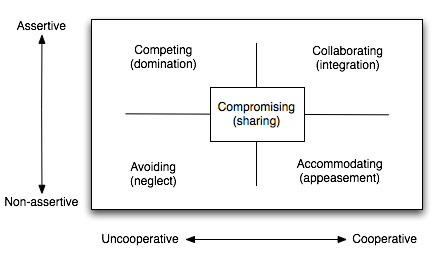
Even in the highest functioning teams, interpersonal conflicts are bound to arise. Employee conflict is a cause of concern for employers, leaders and project managers because it often leads to lost productivity and damaged morale. Project managers must learn to handle interpersonal conflict on their project teams. Doing so will alleviate tension, increase productivity and help create respectful work environments.
How people handle conflict has been an area of study for years. In 1974, Kenneth W.Thomas and Ralph H. Kilmann introduced an assessment called the Thomas-Kilmann Conflict Mode Instrument (TKI) to help determine styles when dealing with conflict.
According to the TKI there are 5 typical styles people use when dealing with conflict:

Accommodating
In this style, a person involved in the conflict chooses to give-in. Utilizing this technique will be at the expense of that person’s ideas and opinions. This approach can be effective when the opposing party is the expert or has more power. Accommodating is the least assertive style which results in very one-sided resolutions.
Avoiding
This is a technique where a person involved simply avoids the conflict. The person disengages without pursuing their own goals. This works when the issue is unimportant or when it is clear that the conflict can’t be resolved, however it is a non-assertive and uncooperative style of conflict resolution. It is important to note that both the accommodating and avoiding styles have the same outcome, however,through avoidance, there is no indication that a contribution was made in solving the conflict.
Collaborating
This is a style where both sides of the conflict come together in order to achieve the goals of each person and is often referred to as creating a “win-win.” Collaborating can be an effective style for complex scenarios where there is an opportunity to explore multiple options. Collaborating conflict resolution means both sides are asserting themselves and their ideas but are also working for a cooperative outcome. The challenge of the collaborative conflict resolution is that it can be time consuming and it requires a high-level of trust between all parties.
Competing
Whereas collaborative conflict resolution can often be called a “win-win” style, competing may be defined as a “win-lose” style. Competing is an autocratic technique for resolving conflict. In it, one person forces their solution at the expense of the other party . This style may be appropriate when one person has the power to make the decision and needs to do so quickly and decisively, however, competing is the most aggressive and uncooperative conflict resolution method.
Compromising
This is a style of conflict resolution where each party gives-up part of their objectives. Although the compromising style may seem similar to collaborating, it is different. In compromising, people make trade-offs that drive a hybrid solution to the conflict. Since neither party gets what they want it can be defined as a “lose-lose” model. Compromising requires a moderate level of assertiveness and cooperation and it is effective when people are working on short term tasks or on a smaller part of a project.
By becoming familiar with the different styles of conflict resolution, project managers can apply the most effective techniques of resolving conflict to ensure project teams avoid disruptions and stay productive.

Turn project data into professional timelines
Get the advanced features of Office Timeline Pro+ free for 14 days.
Get free trial